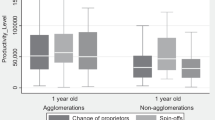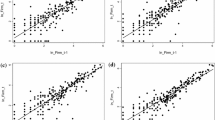Abstract
This paper investigates how business establishment entry and exit are affected by cycles in business density. We assess how entry/exit behave when markets over and under shoot a dynamic equilibrium number of businesses and whether these effects differ between manufacturing and service industries. Overall, we find persistent cycles where the actual number of business establishments is typically not equal to the dynamic equilibrium number even though it gravitates towards it. We uncover a systematic pattern which indicates that in disequilibrium entry is dis-equilibrating while closure is equilibrating. For example, the entry rate plays a dis-equilibrating role by accelerating in an overshoot, however as exits accelerate even faster in an overshoot they help move the industry towards an equilibrium. Overall, the results indicate that entrepreneurs and corporations operate with a herd instinct thereby increasing establishments in a cyclical business density over shoot and decreasing them in an under shoot. In terms of economic policy, the results question whether government policy aimed at promoting business creation and expansion ought to have a counter business density cyclical dimension. In other words, should business start-up and growth be promoted more strongly in business density under shoots than over shoots?

Similar content being viewed by others
Notes
In essence, the alternative (which is not an option from our dataset) using data on the number of businesses has the weakness that single and multi establishment firms are counted as the same which is highly questionable in an analysis attempting to establish long term equilibrium relationships. By contrast, establishment/plant data (especially having controlled for minimum efficient scale) provides a more reliable measure of business supply capacity which would be expected to have some long term equilibrium relationships with measures of market size/capacity.
See definition at http://www.census.gov/epcd/susb/introusb.htm#definitions
Another explanation could be that because manufacturing establishments have longer gestation periods, they may be less responsive to yearly changes in GVA.
References
Audretsch, D. B. (2002). The dynamic role of small firms: evidence from the US. Small Business Economics, 18, 13–40.
Audretsch, D. B., Baumol, W. B., & Burke, A. E. (2001). Competition policy in dynamic markets. International Journal of Industrial Organization, 19, 613–634.
Blau, D. M. (1987). A time series analysis of self-employment in the United States. Journal of Political Economy, 95, 445–467.
Burke, A. E., van Stel, A., & Thurik, R. (2010). Blue Ocean vs. Five Forces. Harvard Business Review, May, 28.
Carree, M., & Thurik, R. (1994). The dynamics of entry, exit and profitability: an error correction approach for the retail industry. Small Business Economics, 6, 107–116.
Dasgupta, P., & Stiglitz, J. (1980). Industrial structure and the nature of innovative activity. Economics Journal, 90, 266–293.
Day, G. S. (1997). Strategies for surviving a shakeout. Harvard Business Review, 75(2), 92–102.
Demsetz, H. (1982). Barriers to entry. American Economic Review, 72(1), 47–57.
Dunne, T., Roberts, M. J., & Samuelson, L. (1988). Patterns of firm entry and exit in US manufacturing industries. RAND Journal of Economics, 19(4), 495–515.
Eaton, B. C., & Lipsey, R. G. (1980). Exit barriers are entry barriers: the durability of capital as a barrier to entry. Bell Journal of Economics, 11(2), 721–729.
Friedman, M. (1953). Essays in positive economics. Chicago: University of Chicago Press.
Geroski, P. A. (1995). What do we know about entry? International Journal of Industrial Organization, 13, 450–456.
Geroski, P. A. (2001). Exploring the niche overlaps between organizational ecology and industrial economic. Industrial and Corporate Change, 10(2), 507–540.
Griliches, Z. (Ed.). (1984). R & D, patents and productivity. Chicago: University of Chicago Press.
Highfield, R., & Smiley, R. (1987). New business starts and economic activity; an empirical investigation. International Journal of Industrial Organization, 5, 51–66.
Mansfield, E. (1962). Entry, Gibrat’s Law, innovation and the growth of firms. American Economic Review, 52(5), 1023–1051.
Marshall, A. (1890). Principles of Economics. London: Macmillan and Company (reprinted in 1920).
Martin, S. (2002). Advanced industrial economics (2nd ed.). Malden: Blackwell Publishing.
Orr, D. (1974). The determinants of entry: a study of the Canadian manufacturing industries. The Review of Economics and Statistics, 56, 58–66.
Pakes, A., & Schankerman, M. (1984). An exploration into the determinants of research intensity. In Z. Griliches (Ed.), R & D, patents and productivity. Chicago: University of Chicago Press.
Parker, S. (1996). A time series model of self-employment under uncertainty. Economica, 63, 459–475.
Porter, M. E. (1980). Competitive strategy. New York: The Free Press.
Reynolds, P. (1994). Autonomous firm dynamics and economic growth in the United States, 1986–1990. Regional Studies, 28(4), 429–442.
Robson, M. T., & Wren, C. (1999). Marginal and average tax rates and the incentive for self-employment. Southern Economic Journal, 65, 757–773.
Schmalensee, R. (1981). Economies of scale and barriers to entry. Journal of Political Economy, 89(6), 1228–1238.
Schuetze, H. J. (2000). Taxes, economic conditions and recent trends in male self-employment: a Canada-US comparison. Labour Economics, 7, 507–544.
Schumpeter, J. A. (1939). Business cycles. New York: McGraw-Hill.
Schumpeter, J. A. (1942). Capitalism, Socialism and Democracy. New York, NY: Harper (reprinted in 1975).
Shapiro, D., & Khemani, R. S. (1987). The determinants of entry and exit reconsidered. International Journal of Industrial Organization, 5, 15–26.
Siegfried, J. J. & Evans, L. B. (1994). Empirical studies of entry and exit: a survey of the evidences. Review of Industrial Organization, 9, 121–155.
Small Business Administration. (2003). Small Serial Innovators: The small firm contribution to technical change. SBA Study commissioned under contract number SBAHQ-01-C-0149
Smith, A. (1776). Inquiry into the Nature and Causes of the Wealth of Nations. Chicago, IL, University of Chicago Press (reprinted in 1976).
Storey, D. J. (1991). The birth of new firms – does unemployment matter? A review of the evidence. Small Business Economics, 3(3), 167–178.
Tirole, J. (1988). The theory of industrial organization. Cambridge: The MIT Press.
Acknowledgements
The authors are grateful for comments by referees and participants at various seminar presentations of the research, which have helped to improve the paper. The usual disclaimer applies.
Author information
Authors and Affiliations
Corresponding author
Appendix: Description of variables and data sources
Appendix: Description of variables and data sources
Establishments (N), establishment births (E), and establishment deaths (F)
According to Statistics of US Businesses (SUSB) “an establishment is a single physical location at which business is conducted or services or industrial operations are performed”. These range in size from 1 to 4 employees to 500+ employees, and are classified according to the 4-digit NAICS classification system. Data on these have been obtained from the website of US Small Business Administration (SBA) Office of Advocacy. We use the log of N, E and F for all analyses.
Value added to total US GVA by industry sectors
Gross value added (GVA) is equal to an industry’s annual gross output minus its intermediate input. This data is obtained from Bureau of Economic Analysis (BEA). With the exception of retail and wholesale industry which is aggregated at the two digit NAICS level, value added for other industries is available at the three digit industry level. We convert the nominal GVA to real values using the GDP deflator for the year 2000 as the base and use its log form in the analysis.
R & D expenditure
Research and Development (R & D) expenditure is calculated as a percentage of total industry sales based on the 3-digit NAICS classification for each year of the analysis. This data is also obtained from the Bureau of Economic Analysis (BEA).
Small firm share of patents
The Small Business Administration (2003, Table 6, p. 17) reports the small firm share of patenting technology by technology areas which are broadly aligned with the NAICS/SIC industry classification. We use the data from this table to create a variable capturing the percentage share of patenting by small businesses in different industries.
Minimum efficient scale
We measure the minimum efficient scale requirement in each of the four-digit industries, as the average size (in terms of employees) of the largest plants accounting for 50 % of the industry employment.
Income tax rate
This is the average annual income tax rate on personal income. Data on this variable has been obtained from the tax statistics site of the US Internal Revenue Service website.
Unemployment rate
This is the annual unemployment rate for the US. Data on this variable has been obtained from the Bureau of Labor Statistics, U.S. Department of Labor.
Lagged residuals
These are the lagged residuals ε it-1 from the regression of N*. These capture the deviation of actual from sustainable level of business establishments in the previous period.
Overshoots and undershoots
An over shoot indicator of ε it-1 is created by placing a value of zero (where the value of ε it-1 is negative), and vice versa for an under shoot measure.
Rights and permissions
About this article
Cite this article
Burke, A., Shaukat, A. Establishment creation and destruction across business density cycles: US evidence. Int Entrep Manag J 11, 377–392 (2015). https://doi.org/10.1007/s11365-014-0337-0
Published:
Issue Date:
DOI: https://doi.org/10.1007/s11365-014-0337-0




